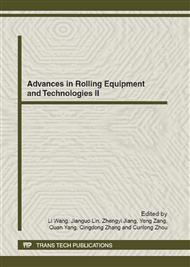p.215
p.221
p.227
p.232
p.237
p.243
p.249
p.255
p.261
Numerical Simulation and Experiment on Quenching Process of 718 Mould Steel with New Online Hardening Equipment
Abstract:
A new type online hardening equipment for quenching has been developed by University of Science and Technology Beijing and Dongbei Special Steel Group in Dalian Special Steel Co., LTD., which consists of strong water jet, medium water jet, weak water jet, air-water spray and side water jet and has flexible cooling and control ability. Based on the equipment, the online quenching process of 718 mould steel is performed by numerical simulation and field experiment. The result of temperature field by numerical simulation agrees well with that of experiment, which can prove that numerical simulation can be very good guidance for field experiment. Experimental tempering hardness difference of 718 mould steel can be controlled within 2 HRC in the whole plate according to numerical simulation. Prediction technology can meet the different cooling rate control and make quenching process comply with preset quenching route to guarantee material microstructure and performance.
Info:
Periodical:
Pages:
237-242
Citation:
Online since:
October 2012
Authors:
Keywords:
Price:
Сopyright:
© 2012 Trans Tech Publications Ltd. All Rights Reserved
Share:
Citation:


